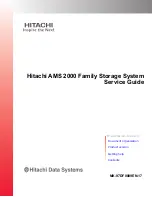
●
Use heel straps, toe straps, or boot straps at standing workstations. Wear the straps on both feet when
standing on conductive floors or dissipating floor mats.
●
Use conductive field service tools.
●
Use a portable field service kit with a folding static-dissipating work mat.
If you do not have any of the suggested equipment for proper grounding, have an authorized technician install the part.
For more information about static electricity or assistance with product installation, contact customer support. For additional
information, see
.
Dealing with hardware faults
Ensure that you have obtained a replacement module of the same type before removing any faulty module.
CAUTION:
●
If the enclosure system is powered up and you remove any module, replace it immediately. If the enclosure
system operates for too long with a module removed, the enclosures can overheat, causing power failure and
potential data loss. Such use may invalidate the warranty.
●
Observe applicable/conventional ESD precautions when handling modules and components as described in
. Avoid contact with midplane components, module connectors, leads, pins, and exposed
circuitry.
Firmware updates
After installing the hardware and powering on the storage system components for the first time, verify that the controller
modules, expansion modules, and disk drives are using the current firmware release. Periodically, ensure that the firmware
versions used in the enclosure modules are compatible.
Partner firmware update
Partner firmware update (PFU) is enabled on the system by default. With PFU enabled, when you update firmware on one
controller or replace a controller, the system automatically updates the partner controller. Disable PFU only if requested by a
service technician. Use the PowerVault Manager or CLI to change the PFU setting.
For a dual-controller system, the partner firmware update (PFU) setting (
Settings > System > Properties > Firmware
Properties
) controls how updates impact the partner controller:
●
Automatic
—PFU is enabled (the default). When you activate controller module firmware on one controller, the firmware
is automatically copied over and activated on the partner controller first, and then activated on the current controller. PFU
provides for updating expansion module firmware in similar fashion.
●
Manual
—PFU is disabled. When you update controller module or enclosure IOM firmware on one controller, you must log
into the partner controller and manually perform the same updates.
When a controller module is installed into an enclosure at the factory, the enclosure midplane serial number and firmware-update
timestamp are recorded for each firmware component in controller flash memory, and will not be erased when the configuration
is changed or is reset to defaults. These two pieces of data are not present in controller modules that are not factory-installed
and are used as replacements.
Updating controller firmware with the PFU option enabled ensures that the same firmware version is installed in both controller
modules. PFU uses the following algorithm to determine which controller module will update its partner:
●
If both controllers are running the same firmware version, no change is made.
●
The controller installed first will send its configuration and settings to the partner controller. Similarly, if a controller is
replaced, it will receive configuration information from the partner controller. In both cases, subsequent firmware update
behavior for both controllers is determined by the system's unified PFU setting
●
If both controllers were already installed in the system, then the controller with firmware installed first will send its
configuration and settings to the partner controller.
●
If both controllers are newly installed, then controller A is transferred to controller B.
44
Module removal and replacement















































